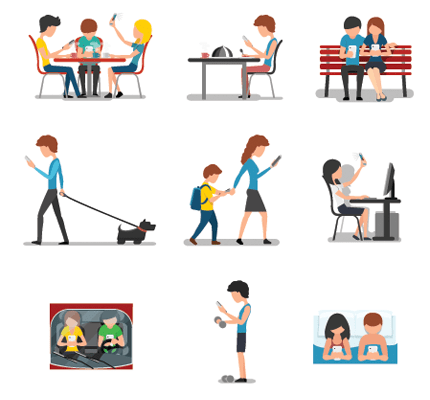
Media Routines Shape Our Days
Many people’s days are structured around routines. Maybe you listen to the radio while getting ready in the morning, or maybe you watch the morning news with breakfast. Perhaps social media is the first thing you turn to as you start your day. In a new article published in Communication Monographs, Anna Schnauber-Stockmann and Frank Mangold draw on structuration theory as a framework for examining the routines that define people’s media use.
Structuration Theory
Anthony Giddens’ structuration theory postulates that social life has a structure that constrains individual actions, such as by indicating what behavior is acceptable at what time. Yet, people are usually unaware of this structure and these unspoken rules. Giddens also argues that our daily actions continually produce and reproduce this structure. In other words, because we repeat daily actions that follow unspoken rules, we ensure that the structure continues to function. Schnauber-Stockmann and Mangold write that, according to the theory, there are two structuring functions: routines as constraints and routines as social zeitgebers (“time-givers” in German).
Routines as Constraints
Media use can be constrained by the media platform itself. For example, most television sets are at home, so people would likely watch TV at home. In contrast, many people have radios in their car, which makes it easy to listen to the radio when commuting. Laptops and smartphones can both be used outside of the home, but laptops require more setup to do so.
Routines are also related to rules, which constrain when an action is socially acceptable. In accordance with structuration theory, many people are both abiding by these rules and re-creating them through their individual actions. For example, while it is socially acceptable to watch television at home, most workplaces (or even work-from-home offices) would not consider it acceptable to watch television while working. In contrast, it is more acceptable to listen to the radio while working or doing other activities.
New media platforms have less well-defined rules. Computers can be used for leisure or work, and many white-collar workers use computers for leisure while at work (to some degree) without penalty. Smartphones can be used at almost any time, regardless of other obligations or whether one is with friends. While some people may feel “phubbed” (or ignored because of phone use) by the practice, many people use phones in the presence of friends and family.
Routines as Social Zeitgebers
Schnauber-Stockmann and Mangold also draw a connection between routines and “clock time,” or the time of day. Many people’s media use routines are shaped by schedules and time. For example, some people may work from 9 a.m. to 5 p.m., which means that their media use will be influenced by work obligations during that time. Schnauber-Stockmann and Mangold note that “it is not necessarily clock time by itself that guides our actions, but the associated societal circumstances.” Generally speaking, the shift from work time to leisure time in the evening means that more people turn on their televisions after work. However, because of the constant availability of smartphones and other devices, daily routines associated with time may be shifting as the lines between “work” and “leisure” become blurred. For example, it is acceptable to use a smartphone for social purposes during the work day, but it is also becoming acceptable to answer work-related emails after hours.
The Study
Schnauber-Stockmann and Mangold analyzed data collected from 347 German participants as part of a diary study about media platform use. Over a two-week period, participants reported on their use of televisions, radios, computers, and smartphones, where they used these media platforms (at home or somewhere else), what they were doing at the time (working/studying/housework or leisure), and their social surroundings at the time (alone or not).
Results
Generally, television viewing was most strongly associated with routines. People were more likely to watch television during the afternoon and evening hours and during leisure time. This corresponds with off-hours during many people’s work days and to the hours for primetime television programming. People also were most likely to watch television at home and were likely to be alone. In contrast, the use of radio decreased in the afternoon and evening. People often listened to the radio earlier in the day, while engaging in other activities.
In contrast, smartphones and computers were not strongly tied to routines. Smartphones were often used throughout the day, regardless of whether people were working or enjoying leisure time. However, people were a little more likely to use smartphones when they were alone. Generally, computer use was a little more likely to occur during leisure time and when alone.
Generational Differences
Schnauber-Stockmann and Mangold found generational differences in media platform use. The results showed that older populations had a more routinized use of traditional media (television and radio) than younger populations. They typically watched television in the evening hours after work and listened to the radio in the afternoon. Older populations were more likely to use computers and smartphones in the afternoon as well. They were also likely to use radio while engaged in other activities and when with others. In contrast, television viewing was more likely to occur when alone, which demonstrates that the routines were affected by obligations and the social setting, as well as time. Older respondents were also somewhat more likely to use smartphones away from home. Younger respondents used television in a similar manner to older respondents (at home and during leisure time). They were also likely to use computers in a similar way and were likely to use smartphones when with others. However, they were otherwise less likely to use media platforms in a routinized way.
Conclusion
The study showed that many individuals had routines associated with media platforms and that these routines were shared across social groups. Schnauber-Stockmann and Mangold argue that one effect of digitization is to “[blur] the lines between work and leisure time.” One implication of structuration theory is that individual behaviors shape when media use is socially acceptable. As Schnauber-Stockmann and Mangold write, “by regularly using media in the way they do, people (mostly unconsciously) produce structures that later restrict their choices.” One implication of this is that the use of digital media at any time may come to constrain individual behaviors by creating the expectation that people are available for work-related needs outside of work.



